11585606910
Roche
DIG-High Prime
sufficient for 40 labeling reactions, pkg of 160 μL, solution
Synonym(s):
DIG system
Sign Into View Organizational & Contract Pricing
All Photos(3)
About This Item
UNSPSC Code:
41105500
Recommended Products
form
solution
Quality Level
usage
sufficient for 40 labeling reactions
packaging
pkg of 160 μL
manufacturer/tradename
Roche
greener alternative product characteristics
Designing Safer Chemicals
Learn more about the Principles of Green Chemistry.
sustainability
Greener Alternative Product
greener alternative category
storage temp.
−20°C
General description
DIG-High Prime has enzyme and nucleotide mixture for rapid random-primed labeling of DNA with Digoxigenin-11-dUTP. In this method, the complementary DNA strand of denatured DNA is synthesized by Klenow polymerase using the 3′-OH termini of the random oligonucleotides as primers. DIG-labeled probes are generated at high yield within one hour or after overnight incubation.
We are committed to bringing you Greener Alternative Products, which adhere to one or more of The 12 Principles of Greener Chemistry. This product is designed as a safer chemical. The DIG System was established as a sensitive and cost-effective alternative to radioactivity for the labeling and detection of nucleic acids. There are many available publications that prove the versatility of the DIG System, so use of radio-labeling is no longer the only option for labeling of DNA for hybridization.
Specificity
Heat inactivation: Stop the reaction by adding 2 μl 0.2 M EDTA (pH 8.0) and/or by heating to 65 °C for 10 minutes.
Application
DIG-High Prime-labeled DNA probes has been used in a variety of hybridization techniques :
- in Southern blots
- in northern blots
- in dot/slot blots
- for screening of gene libraries
- in In situ hybridizations
Features and Benefits
DIG-High Prime guarantees efficient labeling of:
Labeling efficiency:
A standard labeling reaction with 1μg template yields 0.8μg newly synthesized digoxigenin-labeled DNA after 1 hour, and 2μg after a 20-hour incubation at +37°C.
Contents
5x concentrated random primer mix: 1U/ μl Klenow polymerase, labeling grade, 1mM dATP, 1mM dCTP, 1mM dGTP, 0.65mM dTTP, 0.35mM DIG-11-dUTP, alkali labile in 50% (v/v) glycerol.
- DNA amounts ranging from 10ng to 3μg in a standard reaction.
- DNA of different lengths ranging from small restriction fragments to λ or cosmid DNA.
- DNA, supercoiled or linearized.
- DNA in low melting-point agarose.
Labeling efficiency:
A standard labeling reaction with 1μg template yields 0.8μg newly synthesized digoxigenin-labeled DNA after 1 hour, and 2μg after a 20-hour incubation at +37°C.
Contents
5x concentrated random primer mix: 1U/ μl Klenow polymerase, labeling grade, 1mM dATP, 1mM dCTP, 1mM dGTP, 0.65mM dTTP, 0.35mM DIG-11-dUTP, alkali labile in 50% (v/v) glycerol.
Quality
Function test:
In a standard assay with 1μg linearized pBR 328, 0.8μg of DIG-labeled DNA is synthesized after 1 hour, and 2.3μg after 20 hours. When this labeled DNA is used for hybridization at a concentration of 20ng/ml, 0.03pg homologous DNA are detected by chemiluminescence with the anti-DIG-alkaline phosphatase conjugate and CSPD on a dot or Southern blot.
In a standard assay with 1μg linearized pBR 328, 0.8μg of DIG-labeled DNA is synthesized after 1 hour, and 2.3μg after 20 hours. When this labeled DNA is used for hybridization at a concentration of 20ng/ml, 0.03pg homologous DNA are detected by chemiluminescence with the anti-DIG-alkaline phosphatase conjugate and CSPD on a dot or Southern blot.
Principle
DIG-labeled DNA probes are generated with DIG-High Prime according to the random-primed labeling technique. DIG-High Prime is a specifically developed reaction mixture containing Digoxigenin-11-dUTP and all reagents necessary for random-primed labeling, including Klenow enzyme, premixed in an optimized 5x concentrated reaction buffer in 50% glycerol.
Preparation Note
DIG-labeled probes in the reaction mix or in the hybridization buffer are stable for more than 12 months stored at -15 to -25°C. They can be reused several times if freshly denatured before use.
Assay Time: 80 minutes
Sample Materials
Note: To obtain optimal results, template DNA should be linearized and should have a size of = 100bp or larger. Template DNA > 5kb should be restriction-digested using a 4bp cutter prior to labeling.
Assay Time: 80 minutes
Sample Materials
- DNA fragments of at least 100bp
- Linearized plasmid, cosmid or λDNA
- Supercoiled DNA
- Or minimal amounts of DNA (10ng), e.g., DNA restriction fragments isolated from gels or in molten agarose
Note: To obtain optimal results, template DNA should be linearized and should have a size of = 100bp or larger. Template DNA > 5kb should be restriction-digested using a 4bp cutter prior to labeling.
Other Notes
For life science research only. Not for use in diagnostic procedures.
Storage Class Code
12 - Non Combustible Liquids
WGK
WGK 1
Flash Point(F)
No data available
Flash Point(C)
No data available
Choose from one of the most recent versions:
Already Own This Product?
Find documentation for the products that you have recently purchased in the Document Library.
Customers Also Viewed
Light regulation of asexual development in the rice blast fungus, Magnaporthe oryzae
<BIG>Lee K, et al.</BIG>
Fungal genetics and biology : FG & B, 43 (2006)
Characterization of the Chromosomal Transmission of Intergeneric Hybrids of spp. and by Genomic in situ Hybridization.
Wang X
Crop Science, 50, 1642-1648 (2010)
Articles
Digoxigenin (DIG) labeling methods and kits for DNA and RNA DIG probes, random primed DNA labeling, nick translation labeling, 5’ and 3’ oligonucleotide end-labeling.
Our team of scientists has experience in all areas of research including Life Science, Material Science, Chemical Synthesis, Chromatography, Analytical and many others.
Contact Technical Service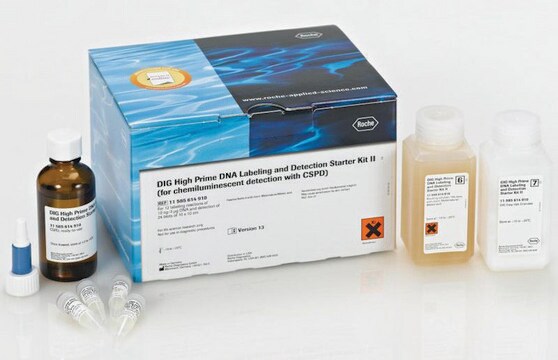
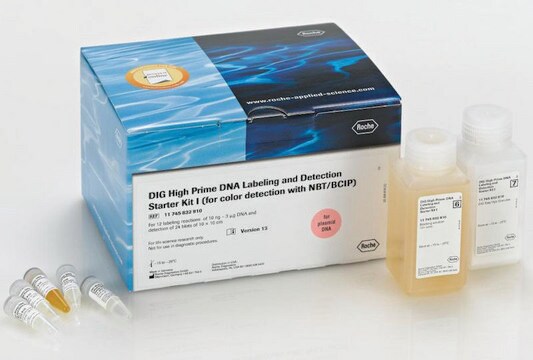

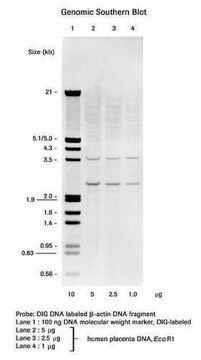
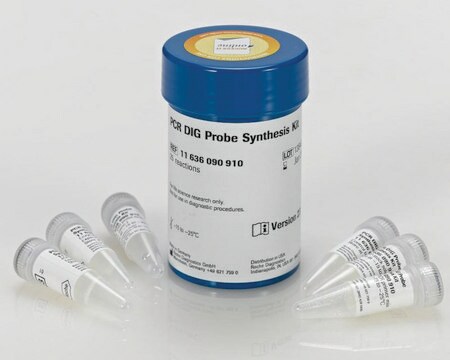
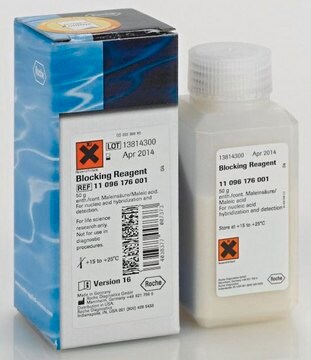
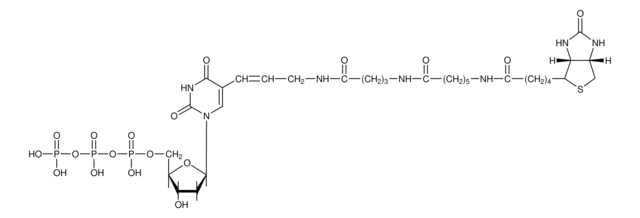
![CSPD ready-to-use Disodium 3-(4-methoxyspiro {1,2-dioxetane-3,2′-(5′-chloro)tricyclo [3.3.1.13,7]decan}-4-yl)phenyl phosphate](/deepweb/assets/sigmaaldrich/product/images/352/091/ef743cea-ccd8-44f1-8f3b-dec5a1e4f5d1/640/ef743cea-ccd8-44f1-8f3b-dec5a1e4f5d1.jpg)
